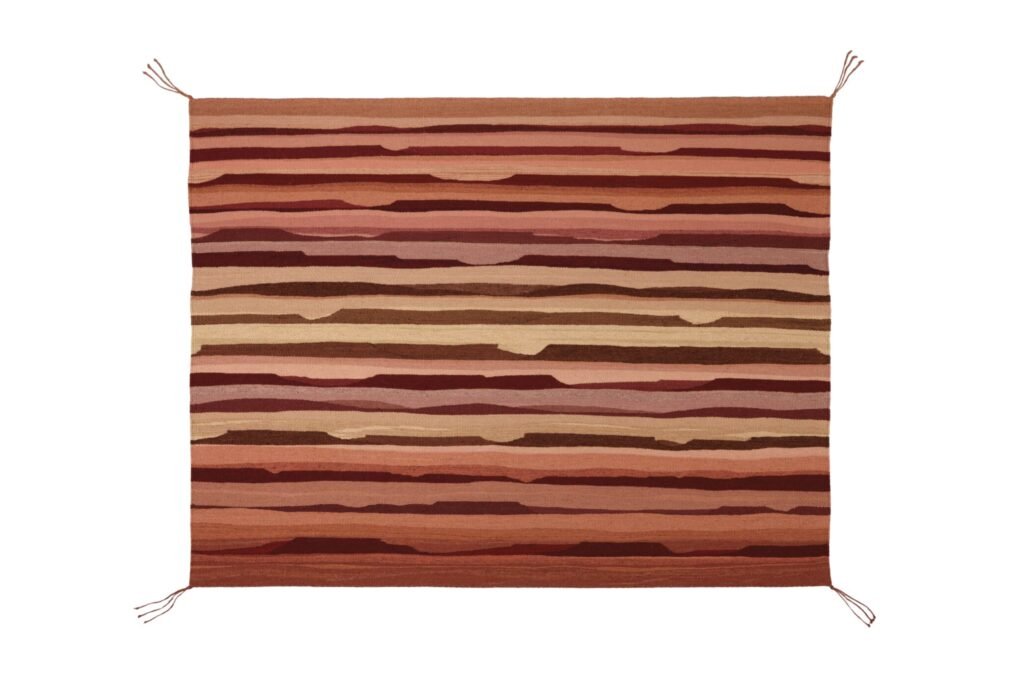Diné artist DY Begay weaves the colors and traditions of her homeland into her tapestries.
In the remote Four Corners region of the Navajo Nation known as Tsélání, Arizona, Diné artist DY Begay has developed her own aesthetic for infusing her weavings with emotive meaning. Working with a large color palette of dyes made from plants and insects, she juxtaposes different colors, frequently using horizontal, undulating lines with gradations of color in abstract compositions that evoke her homeland.
Born in 1953, Begay first learned to weave watching her mother and grandmother process wool from the family sheep herd using tools made by male relatives and working at their looms. “I was born into a family of weavers. I am a [fifth]-generation weaver,” she told umission.org. “As far as I can remember as a young girl, I was always interested in weaving.”
“She works a lot with the colors of the landscape and the shapes of the land. Mesas figure prominently, also the wisps of clouds in the air, the ripples of water in an arroyo. Her art is very responsive to the natural world,” says Cécile Ganteaume, a curator at the Smithsonian’s National Museum of the American Indian who helped mount Sublime Light: Tapestry Art of DY Begay. Consisting of 48 artworks, the exhibition — the first retrospective of the artist’s career — spans from the 1970s to current day.
Tied to the landscape in which Begay was raised and to which much of her identity is attached, the tapestries are modern in their use of color and design. For instance, the piece Tselani is created of taupes and grays with faint images of mesas. “She said she was inspired one morning when she was sitting outside her hogan having her coffee, and off in the distance she could hear sheep bleating as they were leaving their corrals, kicking up dust,” Ganteaume recalls. She was thinking of the dust her great-great-great-grandmother’s enormous herd of sheep must have kicked up each morning.
The curator got to know the artist. “I’ve been out to where she lives on the Navajo Reservation on three occasions,” Ganteaume says. “She’s serene, I would say — methodical, also fun-loving. She likes to cook. She made us Navajo tacos, which were wonderful. It’s very remote there. In the eight-minute film we did for the exhibit, she’s walking through Tsélání and talking about its importance in her art.”
That importance is about lineage, culture, and tradition as much as it is about the landscape that inspires her. “I am very interested in working with elders — especially listening to their stories about weaving, about a way of life, or what they do,” Begay told umission.org. “That makes me think that my weaving is not just a profession, but it is more personal to me. I encourage people to try weaving, to experiment, to explore, to listen to other’s stories and to tell their own.”
Sublime Light: Tapestry Art of DY Begay opens September 20, 2024, at the National Museum of the American Indian in Washington, D.C., and remains on view until September 2025. A book of the same title (with 80 artworks), edited by Ganteaume and Jennifer McLerran, is available from Penguin Random House.
From our August/September 2024 issue.
HEADER IMAGE: Intended Vermillion, 2015. Wool with plant, insect, and synthetic dyes, 49 x 37ó in. Denver Art Museum: Commissioned and funded by Kent and Elaine Olson for the Denver Art Museum, 2015.266.






